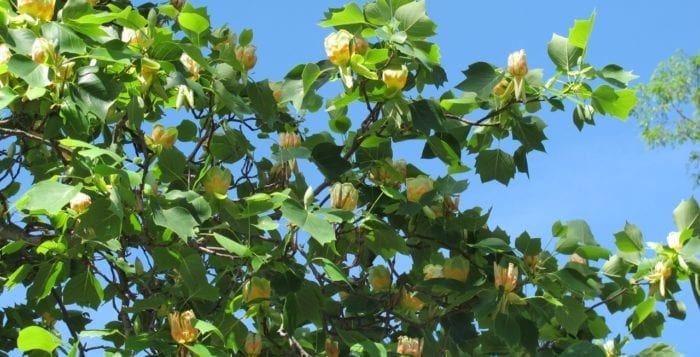By Ellen Barcel
In early June I was driving home from a trip to the East End when I saw a beautiful large tree with creamy colored blooms. Interesting, I thought, only to remember that it must have been a tulip tree (Liriodendron tulipifera), also known as a tulip poplar.
Where did the name tulip tree come from? There are two schools of thought. One is that the shape of the leaves resembles tulip flowers. A second is the shape of the beautiful flowers, which bloom in late May to early June in our area. Or, maybe it’s both!
Actually, spring flowering tulip bulbs and tulip trees are not really related at all, other than the fact that they are both flowering plants. This deciduous tree is definitely colorful. The fragrant, spring flowers are yellowish color with orange splotches deep in the flower. The leaves turn a bright yellow in autumn. They are in the same family as the magnolia tree. Interestingly, neither the magnolia nor the tulip tree blooms as a very young plant; both can take a number of years for seedlings to reach an age where flowers will appear. The wood was used by Native Americans to make canoes. The leaves provide food for the eastern tiger swallowtail butterfly caterpillar, and it is the state tree of Kentucky, Tennessee and Indiana.
Fred Drewes of Heritage Park in Mount Sinai noted that cardinals enjoy eating the winged seed pods (samaras) of the tree.
Now, if you decide that you want to add one or more specimens of this beautiful tree, you need to know some basics, some pros and cons. The tree is native to the eastern part of North America, meaning that you would be adding a native specimen to the area. It’s more adapted to the highs and lows of rainfall and temperature that we commonly have. So, this is a pro.
Note that there is an Asian variety of the tulip tree (Liriodendron chinenese), but the flowers don’t have the orange coloring of the American variety. The tulip tree is hardy (U.S. Department of Agriculture hardiness zones) from zones 4 to 9. With Long Island being zone 7, right in the middle, you can be reasonably confident that your new addition will not suffer from winter-kill, as some of the local crape myrtle and hydrangeas have. The mature size of the tree can be anywhere from 70 to 90 feet tall or more and up to 40 feet wide — this is a big one. It spreads out, providing plenty of shade.
Now, here’s where the home gardener really needs to be careful. Since the tree gets so big and spreads out so much, it can be a positive in the garden if you’re looking for lots of shade and want a shade garden under the tree. On the other hand, if you have a small piece of property and want to plant lots of sun-loving plants — like roses or veggies — then this tree is not for you. The large size can be a great big (pardon the pun) negative.
As with most flowering trees, the tulip tree will do best in full sun but tolerates part shade. Full sun is generally defined as having six or more hours of sun a day. The tree prefers acidic, sandy soil, ideal for Long Island’s soil conditions. It is a fast grower, easily adding one to two feet of height a year and is generally disease and insect resistant.
Ellen Barcel is a freelance writer and master gardener. Send your gardening questions to [email protected]. To reach Cornell Cooperative Extension and its Master Gardener program, call 631-727-7850.







